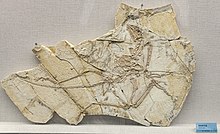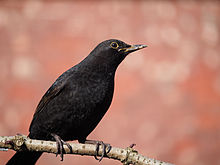Avialae
| Avialans | |
|---|---|

| |
| Espécime fóssil de Jeholornis prima | |

| |
| Turdus merula | |
| Classificação científica | |
| Domínio: | Eukaryota |
| Reino: | Animalia |
| Filo: | Chordata |
| Clado: | Dinosauria |
| Clado: | Saurischia |
| Clado: | Theropoda |
| Clado: | Paraves |
| Clado: | Eumaniraptora |
| Clado: | Avialae Gauthier, 1986 |
| Subgrupos | |
| |
Avialae (avi, aves + alae, asas) é um clado que contém as aves e os dinossauros mais próximos. Jacques Gauthier nomeou o clado em 1986, para incluir as Aves e o Archaeopteryx, baseado em caracteres morfológicos. Constitui um arranjo muito controverso e discutido entre paleontólogos.
Definição
[editar | editar código-fonte]Há muito debate e controvérsias sobre a filogenia dos dinossauros e das aves, e diferentes estudos produzem diferentes resultados. O grupo Avialae pode incluir diferentes subgrupos devido à variação da definição. Incluir ou excluir o Archaeopteryx do grupo das Aves pode ter um grande efeito nesses subgrupos.
Definição baseada em caracteres
[editar | editar código-fonte]Avialae é tradicionalmente definida como um clado baseado em apomorfias, ou seja, com base nas características físicas. Jacques Gauthier, nomeou o clado em 1986,[2] e redefiniu-o em 2001 como, incluindo todos os dinossauros que possuem asas emplumadas usadas no voo batido, e as aves que descendem deles.[3]
Definição baseada na ancestralidade
[editar | editar código-fonte]Na definição baseada na ancestralidade, Avialae compreende todos os terópodes mais aparentados as aves do que ao Deinonychus.[4]
Composição
[editar | editar código-fonte]Segundo Kevian Padian (2004),[5] o clado Avialae era composto pelos seguintes subgrupos, todo são representantes do Mesozoico, exceto pelo Neornithes:
- Alvarezsauridae Bonaparte, 1991
- Rahonavis Forster, Sampson, Chiappe e Krause, 1998
- Archaeopterygidae von Meyer, 1861
- Confuciusornithidae Hou, Zhou, Gu e Zhang, 1995
- Jibeinia Hou, 2000
- Ornithothoraces Chiappe, 1995
- Enantiornithes Walker, 1981
- Ornithurae Haeckel, 1866
- Hesperornithiformes Sharpe, 1899
- Ichthyornithiformes Fürbringer, 1888
- Neornithes Gadow, 1893
- Avialae incertae sedis
- Sapeornis Zhou e Zhang, 2002
- Epidendrosaurus Zhang, Zhao, Xu e Wang, 2002
- Protarchaeopteryx Ji e Ji, 1997
- Archaeopteryx Ji e Ji, 1997
Referências
- ↑ a b Cau, A.; Beyrand, V.; Voeten, D.; Fernandez, V.; Tafforeau, P.; Stein, K.; Barsbold, R.; Tsogtbaatar, K.; Currie, P.; Godefroit, P. (2017). «Synchrotron scanning reveals amphibious ecomorphology in a new clade of bird-like dinosaurs». Nature. 552 (7685): 395–399. Bibcode:2017Natur.552..395C. PMID 29211712. doi:10.1038/nature24679
- ↑ GAUTHIER, J. (1986). Saurischian monophyly and the origin of birds. In: K. Padian, ed. The origin of birds and the evolution of flight. San Francisco: California, Acad. Sci. pp. 1–55. (Mem.Calif.Acad.Sci.8.).
- ↑ GAUTHIER, J.; de QUEIROZ, K. (2001). Feathered dinosaurs, flying dinosaurs, crown dinosaurs, and the name Aves. pp. 7-41 in New perspectives on the origin and early evolution of birds: proceedings of the International Symposium in Honor of John H. Ostrom (J. A. Gauthier and L. F. Gall, eds.). Peabody Museum of Natural History, Yale University, New Haven, Connecticut, U.S.A.
- ↑ SENTER, P. (2007). A new look at the phylogeny of Coelurosauria (Dinosauria: Theropoda). Journal of Systematic Palaeontology.
- ↑ PADIAN, K. Basal Avialae. In WEISHAMPEL, D. B.; DODSON, P.; OSMÓLSKA, H. The Dinosauria. 2ª ed. University of California Press, 2004. p. 880.
Text is available under the CC BY-SA 4.0 license; additional terms may apply.
Images, videos and audio are available under their respective licenses.

















